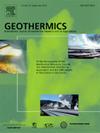A sparrow search algorithm optimized GAN-stacking model for the evaluation of geothermal resource potential assessment
IF 3.9
2区 工程技术
Q3 ENERGY & FUELS
引用次数: 0
Abstract
Currently, in the field of geothermal resource potential prediction, smaller datasets and complexity of geothermal energy formation are the problems that should be effectively addressed. In this work, a GAN-stacking model optimized using sparrow search algorithm (SSA) is constructed, based on artificial neural network (ANN), random forest (RF), support vector machine (SVM), XGBoost, Catboost model, and GIS platform, to predict and evaluate the potential of geothermal resources in Sichuan Province, China. The features include distance from water systems, distance from fracture zones, distance from mountain ranges, seismic kernel density, geothermal heat flow, magnetic anomaly data, distance from igneous rocks, and gravitational gradient anomalies. The receiver operating characteristic curve (ROC) is used for validation. The AUROC values for ANN, RF, SVM, XGBoost, and Catboost are 0.785, 0.834, 0.787, 0.811, and 0.818, respectively, and the AUROC values after enhancing the training set using GAN are 0.793, 0.853, 0.791, 0.840, and 0.839, respectively. The accuracies of all models improve when using extra samples. In addition, the SHAP algorithm is added to analyze the models. The SHAP values of the vast majority of the samples are higher than the SHAP values of the five machine learning models compared in this work, except for the individual extra samples. Subsequently, the sparrow search algorithm-optimized GAN-stacking model is constructed for prediction, and its obtained AUROC value is 0.95. This study shows that the use of GAN to generate extra samples improves the accuracy of geothermal potential prediction models to a certain extent, and the extra samples generated by GANS have a certain degree of confidence. The GAN-stacking model constructed in this study has high accuracy in this study area, and can provide a decision-making basis for the exploration and development of geothermal resources.
利用麻雀搜索算法优化GAN-stacking模型进行地热资源潜力评价
目前,在地热资源潜力预测领域,数据集较小、地热能成因复杂是需要有效解决的问题。基于人工神经网络(ANN)、随机森林(RF)、支持向量机(SVM)、XGBoost、Catboost模型和GIS平台,构建了基于麻雀搜索算法(SSA)优化的GAN-stacking模型,对四川省地热资源潜力进行了预测和评价。这些特征包括与水系统的距离、与断裂带的距离、与山脉的距离、地震核密度、地热热流、磁异常数据、与火成岩的距离以及重力梯度异常。采用受试者工作特征曲线(ROC)进行验证。ANN、RF、SVM、XGBoost、Catboost的AUROC值分别为0.785、0.834、0.787、0.811、0.818,GAN对训练集进行增强后的AUROC值分别为0.793、0.853、0.791、0.840、0.839。当使用额外的样本时,所有模型的准确性都提高了。此外,还加入了SHAP算法对模型进行分析。除了个别的额外样本外,绝大多数样本的SHAP值都高于本工作中比较的五种机器学习模型的SHAP值。随后,构建基于麻雀搜索算法优化的GAN-stacking模型进行预测,得到的AUROC值为0.95。本研究表明,利用GAN生成额外样本在一定程度上提高了地热潜力预测模型的精度,并且GAN生成的额外样本具有一定的置信度。本文构建的gan -叠层模型在研究区具有较高的精度,可为地热资源勘探开发提供决策依据。
本文章由计算机程序翻译,如有差异,请以英文原文为准。
求助全文
约1分钟内获得全文
求助全文
来源期刊

Geothermics
工程技术-地球科学综合
CiteScore
7.70
自引率
15.40%
发文量
237
审稿时长
4.5 months
期刊介绍:
Geothermics is an international journal devoted to the research and development of geothermal energy. The International Board of Editors of Geothermics, which comprises specialists in the various aspects of geothermal resources, exploration and development, guarantees the balanced, comprehensive view of scientific and technological developments in this promising energy field.
It promulgates the state of the art and science of geothermal energy, its exploration and exploitation through a regular exchange of information from all parts of the world. The journal publishes articles dealing with the theory, exploration techniques and all aspects of the utilization of geothermal resources. Geothermics serves as the scientific house, or exchange medium, through which the growing community of geothermal specialists can provide and receive information.
 求助内容:
求助内容: 应助结果提醒方式:
应助结果提醒方式:


